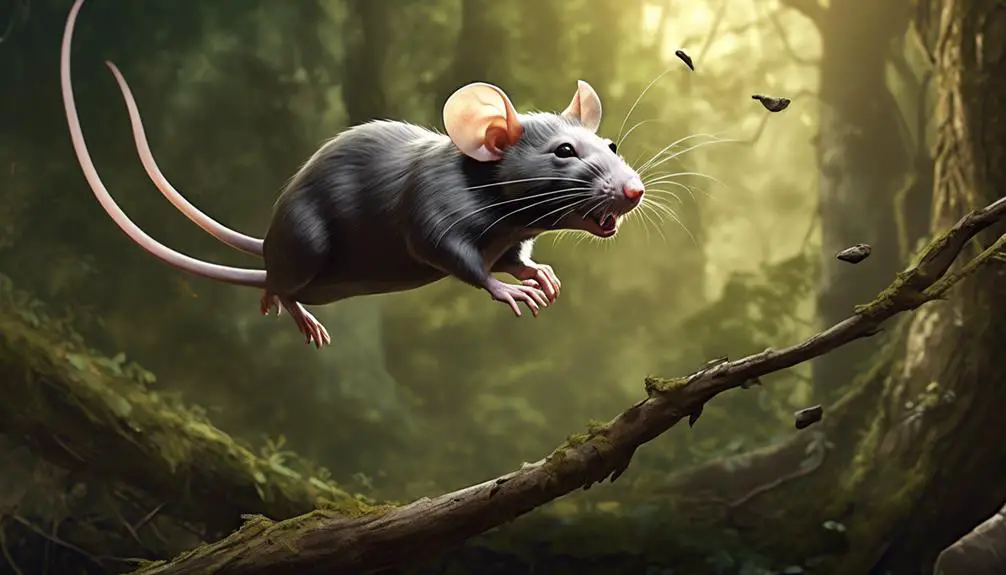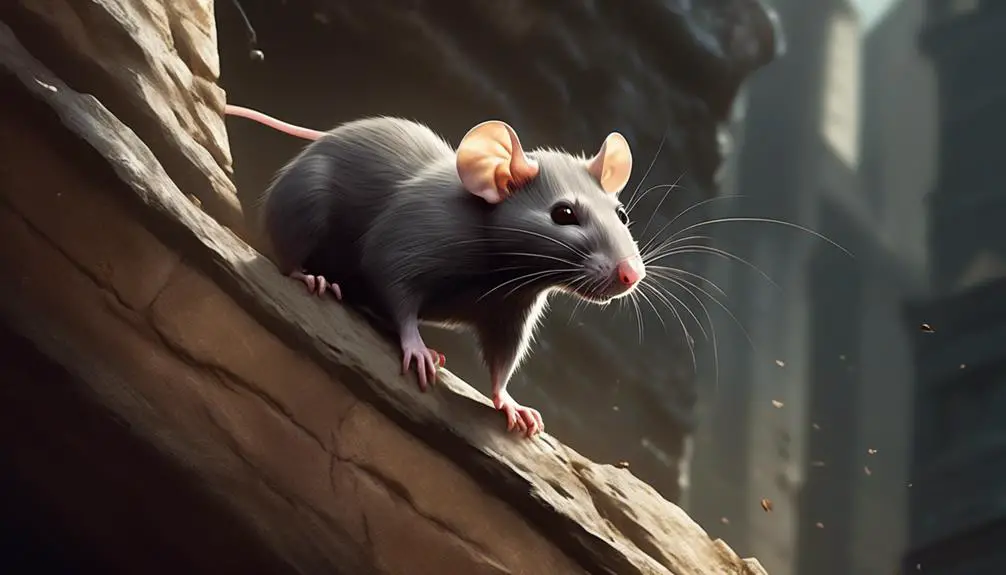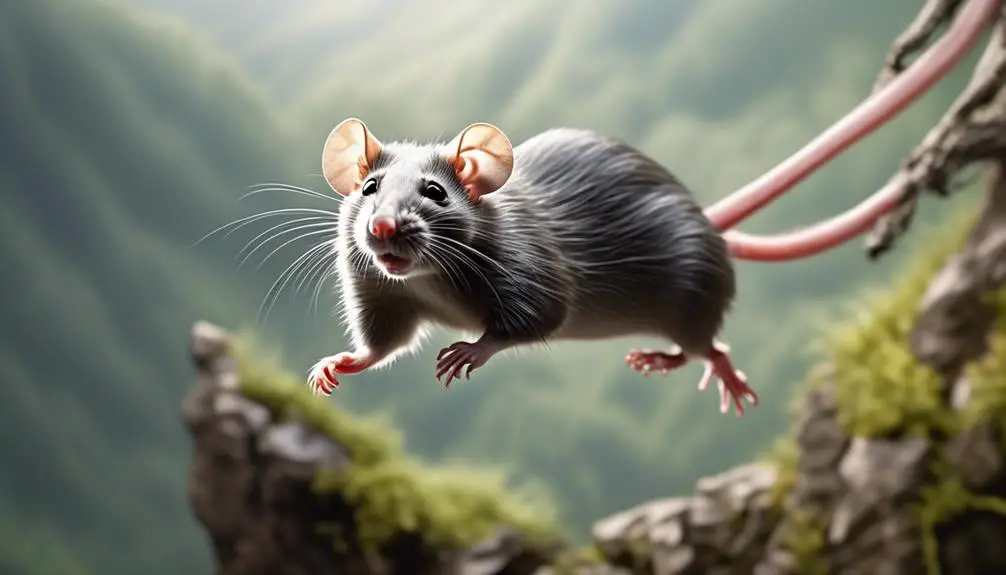Picture this: a rat, suspended in mid-air, hurtling towards the ground at an alarming speed. You might assume that such a fall would be fatal, but the reality is quite astonishing.
Rats possess an uncanny ability to defy the odds and survive even the most treacherous falls. How is this possible? What secrets lie within their tiny bodies that enable them to cheat death when faced with terminal velocity?
In the following discussion, we will delve into the remarkable world of rats’ survival skills, exploring the factors that affect their risk of injury and uncovering the astonishing truth behind their ability to survive falls from great heights.
Prepare to be amazed by the resilience of these small creatures as we unravel the mysteries surrounding their survival against all odds.
Rats’ Ability to Survive Falls
Rats have demonstrated their remarkable ability to survive falls from great heights, as research shows they can endure a fall of up to fifty feet with minimal risk of injury. This is primarily due to their small size, which results in little pull from gravity during the fall. Additionally, rats have the ability to position themselves correctly and land on their feet, which helps them absorb the impact and minimize injuries.
Proper positioning during the fall is crucial for a rat’s survival. Rats instinctively position themselves to land on their paws, which acts as a shock absorber and helps break the fall. Terminal velocity calculations also play a role in determining the potential danger of a fall. Rats can adjust their body posture and position to minimize the risk of injury.
The surface upon which a rat lands also affects the extent of injuries. A fall from 50 feet onto a hard surface, such as concrete, can result in broken bones or paralysis. However, falling onto a softer surface, like a sponge-like material, reduces the likelihood of injuries. Rats have a higher chance of survival if they fall onto a surface that absorbs some of the impact.
Factors Affecting the Risk of Injury
When it comes to rats surviving falls, the positioning during the fall and the impact surface are crucial factors that affect the risk of injury. Proper positioning allows rats to land on their paws and break the fall, minimizing the chance of injuries.
Additionally, the type of surface the rat lands on plays a significant role in determining the extent of injuries.
Fall Positioning Importance
Proper positioning during a fall is crucial for maximizing a rat’s chances of survival and minimizing the risk of injury. When rats fall from great heights, they have the ability to manipulate their body position to reduce the impact force upon landing. By landing on their feet and flexing their limbs, rats can distribute the force of the fall and absorb the impact. This positioning allows them to break their fall and minimize the risk of injuries such as broken bones or paralysis. Additionally, the surface onto which rats land also plays a significant role in determining the extent of injuries. Falling onto a softer surface, such as a sponge-like material, reduces the likelihood of severe harm. The following table summarizes the factors affecting fall positioning importance:
| Factors Affecting Fall Positioning Importance |
|---|
| Landing on feet and flexing limbs |
| Distribution of impact force |
| Minimization of risk of injuries |
Impact Surface Significance
The surface onto which a rat falls plays a significant role in determining the extent of injuries. When a rat falls from a height, the impact surface can greatly influence whether it survives the fall or sustains severe injuries. Falling onto a hard surface, such as concrete, can result in broken bones or even paralysis for the rat. However, if the impact surface is softer, like a sponge-like material, the likelihood of injuries is reduced.
It’s important to note that the distance of the fall isn’t the sole factor in determining the extent of injuries. Even a fall from a relatively low height can be dangerous if the rat lands on a hard surface. Therefore, the impact surface is a crucial consideration when assessing the risk of injury from falls.
Importance of Proper Positioning

Proper positioning is of utmost importance for rats when falling from great heights. Optimal body alignment allows rats to minimize the impact force and reduce the risk of injury.
Optimal Body Alignment
Optimizing body alignment is crucial for rats to minimize the risk of injury when falling from great heights. Proper positioning during a fall allows rats to distribute the impact and reduce the likelihood of severe injuries.
Rats have the ability to land on their feet, which helps them absorb the impact and protect their vital organs. By positioning themselves correctly, rats can break their fall and decrease the force exerted on their bodies. This alignment also enables rats to use their limbs to absorb the shock and prevent bone fractures.
Furthermore, a proper body alignment allows rats to maintain their balance during the fall, increasing their chances of survival. Research on rats’ ability to withstand falls emphasizes the importance of optimal body alignment for their safety and survival.
Landing on Paws
To ensure your survival and minimize the risk of injury when falling from great heights, you must achieve optimal body alignment and position yourself correctly.
When rats fall, they’ve the ability to land on their paws, which helps them survive the impact. Proper positioning during the fall is crucial for your survival.
By positioning yourself correctly, you can break your fall and minimize injuries. Research shows that rats can survive falls from heights of fifty feet or more.
While the impact surface plays a significant role in determining the extent of injuries, landing on your paws can help reduce the likelihood of broken bones or paralysis.
Minimizing Impact Force
When falling from great heights, achieving optimal body alignment and positioning is crucial to minimize the impact force and increase your chances of survival. Proper positioning allows you to distribute the force of the fall more evenly throughout your body, reducing the risk of severe injuries. To illustrate the importance of proper positioning, consider the following table:
| Positioning | Impact Force | Survival Rate |
|---|---|---|
| Head-first | High | Low |
| Feet-first | Moderate | Moderate |
| Feet and back | Low | High |
As seen in the table, positioning yourself feet-first or feet and back can significantly reduce the impact force, increasing your chances of survival. Landing head-first, on the other hand, results in higher impact forces and a lower likelihood of survival. So, remember to prioritize proper body alignment and positioning when faced with a fall from great heights.
Terminal Velocity Calculations
Rats’ survival during falls from great heights can be analyzed through terminal velocity calculations. Terminal velocity is the maximum speed an object can reach while falling through the atmosphere when the force of gravity is balanced by the air resistance. For rats, their small size allows them to experience little pull from gravity and reach a relatively low terminal velocity. By calculating the terminal velocity of a rat, we can determine the potential danger of a fall and assess their chances of survival.
To calculate the terminal velocity of a rat, we must consider factors such as the rat’s mass, surface area, and the density and viscosity of the air. These variables can be plugged into mathematical equations to estimate the rat’s terminal velocity. By comparing the calculated terminal velocity to the actual height from which the rat falls, we can determine if the rat is likely to survive the impact.
Terminal velocity calculations provide valuable insights into the physics behind a rat’s fall. However, it’s important to note that other factors, such as the rat’s ability to position itself correctly during the fall and the nature of the landing surface, also play a significant role in determining the risk of injury. Therefore, while terminal velocity calculations offer a scientific basis for understanding rat survival during falls, they should be considered in conjunction with other factors to fully assess the potential outcomes.
Impact Surface and Extent of Injuries
The impact surface upon which a rat falls plays a significant role in determining the extent of injuries it may sustain. A rat falling from a height of 50 feet onto a hard surface like concrete is at a higher risk of suffering broken bones or paralysis. However, falling onto a softer surface, such as a sponge-like material, reduces the likelihood of injuries.
To further illustrate the impact of different surfaces on rat injuries, consider the following table:
| Surface | Likelihood of Injuries |
|---|---|
| Concrete | High |
| Sponge-like material | Low |
| Grass | Moderate |
As the table demonstrates, the impact surface directly affects the extent of injuries a rat may experience. Falling onto a softer surface, like grass or a sponge-like material, provides a cushioning effect that helps minimize the risk of severe injuries. In contrast, falling onto a hard surface, such as concrete, increases the likelihood of broken bones or other serious injuries.
Therefore, it is crucial to consider the impact surface when assessing the potential harm a rat may suffer from a fall. By providing a softer landing surface, we can increase the chances of a rat surviving a fall from great heights with minimal injuries.
Rats’ Use of Paws for Climbing
Utilizing their paws as adept tools, rats demonstrate remarkable climbing abilities as they scale trees, walls, and the upper parts of buildings. Rats rely on their paws to grip and climb, using them like hands to navigate various surfaces. Their climbing prowess enables them to reach heights of fifty feet or more, giving them access to otherwise inaccessible areas.
To further illustrate the rats’ use of paws for climbing, consider the following table:
| Rats’ Use of Paws for Climbing | |
|---|---|
| Rats’ Ability | Rats use their paws like hands to grip and climb trees and walls. |
| Scampering | Rats can scamper on the walls of buildings to find secure places. |
| Balance | Rats utilize their tail for balance while climbing. |
| Access | Climbing enables rats to reach the upper spaces of trees and buildings. |
Rats are equipped with the necessary physical attributes to excel in climbing. Their nimble paws serve as versatile tools, allowing them to navigate various surfaces with ease. Additionally, their tail acts as a balancing mechanism, providing stability as they ascend heights. Through their exceptional climbing abilities, rats can explore their environment, find shelter, and access resources that would otherwise be out of reach.
Rats’ Ability to Scale Various Surfaces
Rats’ remarkable climbing abilities not only allow them to navigate trees, walls, and buildings but also enable them to scale a variety of surfaces with ease. These agile creatures use their paws like hands to grip and climb, allowing them to reach impressive heights. Rats can scamper on the walls of buildings, using their tails for balance, to find secure places. They rely on their climbing abilities to access the upper spaces of trees and buildings, effectively utilizing their environment. Their ability to scale various surfaces is a result of their anatomical adaptations and muscular strength.
Rats’ paws have specialized structures that aid in climbing. Their sharp claws provide excellent grip on different surfaces, allowing them to cling to rough textures and even smooth surfaces. Additionally, rats have flexible digits that can adapt to the unevenness of the terrain, enhancing their climbing abilities. These adaptations, combined with their muscular strength, enable rats to navigate vertical surfaces effortlessly.
Furthermore, rats’ climbing skills are essential for their survival and foraging activities. By utilizing their climbing abilities, they can access food sources in elevated areas that may be inaccessible to other animals. This gives them a competitive advantage in finding resources and avoiding predators.
Rats’ Reliance on Their Tail for Balance
Rats maintain their balance while climbing by relying on their tail. The tail serves as a crucial tool for stability, allowing rats to navigate various surfaces with ease. Studies have shown that rats use their tail as a counterbalance, adjusting its position to maintain equilibrium while climbing trees, walls, and even the upper parts of buildings.
By using their tail in conjunction with their paws, rats are able to grip onto surfaces and secure their position. This reliance on their tail for balance enables rats to reach heights of fifty feet or more, showcasing their impressive climbing abilities. Additionally, the tail acts as a flexible appendage, aiding in quick adjustments and preventing falls.
Rats’ tails aren’t only important for balance but also play a vital role in their overall agility and survival in their climbing endeavors.
Methods of Climbing Used by Rats

Rats employ their remarkable climbing prowess by using their paws and tail to navigate various surfaces. With their agile paws, rats can grip onto surfaces much like humans use their hands. This enables them to scale trees, walls, and the upper parts of buildings.
Rats can also scamper along the walls of buildings, seeking secure places to hide or access food sources. Their tail plays a crucial role in maintaining balance while climbing, allowing them to maneuver with precision. By relying on their climbing abilities, rats can reach heights of fifty feet or more, giving them access to elevated areas where they can find shelter or escape predators.
Furthermore, their climbing skills allow them to jump off tall buildings, demonstrating their adaptability in navigating urban environments. The combination of their dexterous paws and agile tail enables rats to explore and exploit their surroundings, making them highly successful climbers.
Rats’ Ability to Access Upper Spaces
By utilizing their exceptional climbing abilities, rats are able to effortlessly access the upper spaces of trees and buildings. Rats’ paws function like hands, allowing them to grip and climb various surfaces such as walls, trees, and the upper parts of buildings. They rely on their tail for balance while climbing, enabling them to reach heights of fifty feet or more. This ability to access upper spaces is advantageous for rats in many ways, including finding secure places to rest and forage for food.
To illustrate the rats’ climbing abilities, the following table provides an overview of their methods of climbing:
| Methods of Climbing Used by Rats |
|---|
| – Using paws like hands to climb trees and walls |
| – Scampering on the walls of buildings to find secure places |
| – Utilizing tail for balance while climbing |
| – Accessing the upper spaces of trees and buildings |
| – Relying on climbing abilities to jump off tall buildings |
Rats’ climbing abilities not only allow them to access higher spaces but also contribute to their survival and adaptation in various environments. Their agile climbing skills enable them to navigate complex terrains and escape predators, making them highly adaptable and successful rodents.
Rats’ Reliance on Climbing Abilities
Relying on their agile climbing abilities, rats navigate complex terrains and escape predators, showcasing their remarkable adaptability and survival skills.
Rats are excellent climbers, utilizing their paws like hands to grip and ascend various surfaces. They can scale trees, walls, and the upper parts of buildings, reaching heights of fifty feet or more. Their climbing abilities enable them to access secure places by scampering on the walls of buildings.
Rats rely on their tail for balance while climbing, utilizing it as a counterweight. This tail is crucial in maintaining stability and preventing falls during their ascent. By relying on their climbing skills, rats can jump off tall buildings to escape danger or to gain access to food sources and shelter.
The exceptional climbing abilities of rats highlight their resourcefulness and ability to adapt to different environments. Their nimble movements and keen sense of balance allow them to navigate vertical surfaces, showcasing their remarkable survival instincts.
Rats’ Ability to Jump off Tall Buildings
Navigating vertical surfaces with nimble movements and a keen sense of balance, rats showcase their remarkable survival instincts by utilizing their exceptional climbing abilities to gain access to food sources and shelter, as well as escape danger. Their ability to jump off tall buildings is a testament to their agility and adaptability.
Rats rely on their climbing skills to reach the upper parts of buildings, where they can find secure places to nest and scavenge for food. When it comes to jumping off tall buildings, rats employ a combination of their climbing prowess and their ability to break their fall. By positioning themselves correctly and using their tail for balance, rats are able to minimize the risk of injuries upon impact.
While the distance of the fall plays a role in determining the extent of injuries, the surface they land on is equally important. Falling onto a softer surface, such as grass or vegetation, reduces the likelihood of broken bones or paralysis.
Rats’ ability to jump off tall buildings is a testament to their resourcefulness and adaptability in urban environments.

Erzsebet Frey (Eli Frey) is an ecologist and online entrepreneur with a Master of Science in Ecology from the University of Belgrade. Originally from Serbia, she has lived in Sri Lanka since 2017. Eli has worked internationally in countries like Oman, Brazil, Germany, and Sri Lanka. In 2018, she expanded into SEO and blogging, completing courses from UC Davis and Edinburgh. Eli has founded multiple websites focused on biology, ecology, environmental science, sustainable and simple living, and outdoor activities. She enjoys creating nature and simple living videos on YouTube and participates in speleology, diving, and hiking.

